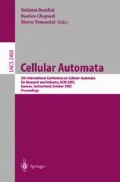Abstract
Understanding of urban growth process is highly crucial in making development plan and sustainable growth management policy. As the process involves multi-actors, multi-behavior and various policies, it is endowed with unpredictable spatial and temporal complexities, it requires the occurrence of new simulation approach, which is process-oriented and has stronger capacities of interpretation. In this paper, A cellular automata-based model is designed for understanding the temporal process of urban growth by incorporating dynamic weighting concept and project-based approach. We argue that this methodology is able to interpret and visualize the dynamic process more temporally and transparently.
Access this chapter
Tax calculation will be finalised at checkout
Purchases are for personal use only
Preview
Unable to display preview. Download preview PDF.
References
Xie, Y. and Batty, M., Automata-based exploration of emergent urban form. Geographical System, (1997) 83–102.
Allen, P.M., Cities and regions as evolutionary, complex systems. Geographical systems, (1997) 103–130.
Batty, M. and Torrens, P.M., Modeling complexity: the limits to prediction. CyberGeo, (2001).
Couclelis, H., From cellular automata to urban models: new principles for model development and implementation. Environment and Planning B, (1997) 165–174.
Batty, M., Xie, Y., and Sun, Z., Modelling urban dynamics through GIS-based cellular automata. Computers, Environment and Urban Systems, (1999) 205–233.
Clarke, K.C. and Gaydos, L.J., Louse-coupling a CA model and GIS: long-term urban growth prediction for San Franciso and Wanshington/Baltimore. Interlational Journal of Geographical Information Science, (1998) 699–714.
White, R. and Engelen, G., High resolution integrated modelling of the spatial dynamics of urban and regional systems. Computers, Environment and Urban systems, (2000) 383–440.
Yeh, A.G. and Xia, L., A constrained CA model for the simulation and planning of sustainable urban forms by using GIS. Environment and Planning B, (2001) 733–753.
Ward, D.P., Murray, A.T., and Phinn, S.R., A Stochastically constrained cellular model of urban growth. Computers, Environment and Urban Systems, (2000) 539–558.
O’Sullivan, D., Graph-cellular automata: a generalised discrete urban and regional model. Environment and Planning B, (2001) 687–705.
Torrens, P.M. and O’Sullivan, D., Editorial: Cellular automata and urban simulation: where do we go from here? Environment and Planning B, (2001) 163–168.
Dragicevic, S., Marceau, D.J., and Marois, C., Space, time, and dynamics modeling in historical GIS databases: a fuzzy logic approach. Environment and Planning B, (2001) 545–562.
Wu, F. and Yeh, A.G.-O., Changing spatial distribution and determinants of land development in Chinese cities in the transition from a centrally planned economy to a socialist market economy: a case study of Guangzhou. Urban Studies, (1997) 1851–1879.
Muth, R., Cities and Housing: The Spatial Pattern of Urban Residential Land Use, Chicago University Press, Chicago, IL. (1969)
Anas, A., Residential Location Markets and Urban Transportation: Economic Theory, Econometrics and Policy Analysis with Discrete Choice Models, Academic Press, NewYork (1982)
Li, X. and Yeh, A.G.-O., Calibration of cellular automata by using neural networks for the simulation of complex urban systems. Environment and Planning A, (2001) 1445–1462.
Herbert, D.T. and Thomas, C.J., Cities in Space: City as place, 3nd edn, David Fulton Publishers, London (1997)
Wu, F., An experiment on the generic polycentricity of urban growth in a cellular automata city. Environment and Planning B, (1998) 731–752.
Bernard, R.N., An application of agent-based modelling to planning policy: the case of rent control, in Department of urban planning and policy development, Rutgers University, (1999)
Author information
Authors and Affiliations
Editor information
Editors and Affiliations
Rights and permissions
Copyright information
© 2002 Springer-Verlag Berlin Heidelberg
About this paper
Cite this paper
Cheng, J., Masser, I. (2002). Cellular Automata Based Temporal Process Understanding of Urban Growth. In: Bandini, S., Chopard, B., Tomassini, M. (eds) Cellular Automata. ACRI 2002. Lecture Notes in Computer Science, vol 2493. Springer, Berlin, Heidelberg. https://doi.org/10.1007/3-540-45830-1_31
Download citation
DOI: https://doi.org/10.1007/3-540-45830-1_31
Published:
Publisher Name: Springer, Berlin, Heidelberg
Print ISBN: 978-3-540-44304-9
Online ISBN: 978-3-540-45830-2
eBook Packages: Springer Book Archive

